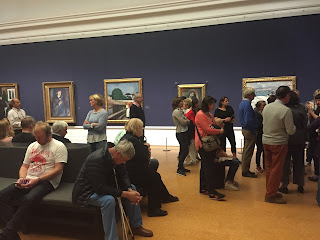Farewell to a difficult man
Steve Jobs reminded me of the only modern architect I’ve known personally who rivaled the Victorian ones in the totality of his vision, realized down to the tiniest details. (That architect is George Homsey. His partner Joseph Esherick said to me once that “it takes someone as pigheaded as George to do anything good." Norman Foster, whose HSBC Building in HK was described to me by Tunney Lee as "the last Victorian building," is another architect who resembles Jobs.)
Jobs had many accomplishments, but what may stick is the understanding he gave us that anything good takes hard work. Much of what he did built on the germs of ideas that others attempted first. Jobs never attempted anything. He got it done. His failures seemed to fuel his desire to put his vision across. They also seemed to enlarge his vision.
From the beginning, he saw that technology needs creativity to find its spark. SFMOMA has an exhibit of Dieter Rams’ work for Braun. That body of work is a precedent for Apple’s products, as are iconic “driver’s machines” like the BMW 2002. But there was always more to the story with Jobs, because after all he was an entrepreneur. The products are gorgeous, but they’re usually portals to content that Apple controls. Control may end up being the weak point in Apple’s strategy. It’s why Amazon and Google, both committed to openness, are its main rivals.
Ever since it was announced, I’ve had reservations about Apple’s proposed headquarters, the design of which Foster generously attributed to Jobs. It perfectly embodies Apple’s culture, but this is not necessarily what it should do. To compete with its rivals, Apple may need to open up. Jobs' crystal palace may allow this, but it’s so singular - and insular - that it could end up feeling like a mausoleum. It will take real courage on Apple’s part to question it, but they should. One way to do this is to imagine a very different company, then ask if this is the building it would choose.
Jobs had many accomplishments, but what may stick is the understanding he gave us that anything good takes hard work. Much of what he did built on the germs of ideas that others attempted first. Jobs never attempted anything. He got it done. His failures seemed to fuel his desire to put his vision across. They also seemed to enlarge his vision.
From the beginning, he saw that technology needs creativity to find its spark. SFMOMA has an exhibit of Dieter Rams’ work for Braun. That body of work is a precedent for Apple’s products, as are iconic “driver’s machines” like the BMW 2002. But there was always more to the story with Jobs, because after all he was an entrepreneur. The products are gorgeous, but they’re usually portals to content that Apple controls. Control may end up being the weak point in Apple’s strategy. It’s why Amazon and Google, both committed to openness, are its main rivals.
Ever since it was announced, I’ve had reservations about Apple’s proposed headquarters, the design of which Foster generously attributed to Jobs. It perfectly embodies Apple’s culture, but this is not necessarily what it should do. To compete with its rivals, Apple may need to open up. Jobs' crystal palace may allow this, but it’s so singular - and insular - that it could end up feeling like a mausoleum. It will take real courage on Apple’s part to question it, but they should. One way to do this is to imagine a very different company, then ask if this is the building it would choose.


Comments
Post a Comment